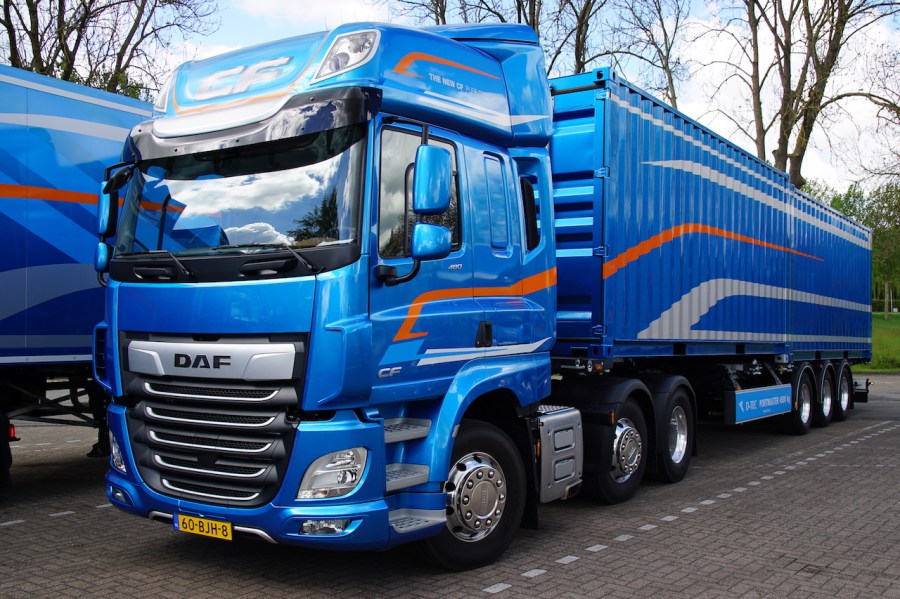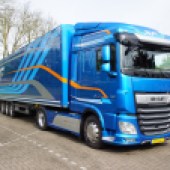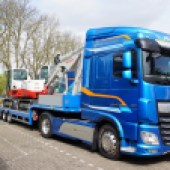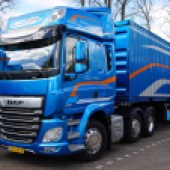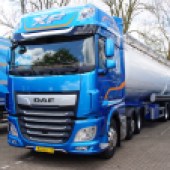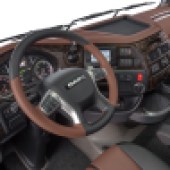The latest DAFs have a huge range of upgrades and improvements, including an all-new transmission. Here’s the lowdown – and our first impressions.
DAF launched their new range of XF and CF trucks at the CV Show back in April. Described as a “new generation” the new models promised a 7% fuel saving over the outgoing models, and class-leading efficiency. The initial press releases on social media explained the many changes and improvements, but this seemingly went straight over the head of a lot of people who said “but that looks just like the old model”. Well, yes they do. But under the skin these trucks are very different. Euro 6 has been with us for almost four years now, and no truck manufacturer can afford to stand still. DAF has been busy; this isn’t just a nip and tuck job. Think of it as Euro 6.5 if you like.
The engines have been heavily revised, the engine brake has been improved on the MX13, there’s all new Traxon tranmissions, new rear axles, new software, various aerodynamic improvements and new interior options.
Trucking had the opportunity to travel to Holland for a series of short test drives, talk to DAF’s technical team and attend a presentation explaining the changes to the new trucks. Here’s a run-down of what’s been done, and our first impression of the trucks.
ENGINES
Both the 11 and 13-litre MX engines have been extensively reworked. As you can see from the chart, the BHP outputs of each engine have been raised, which is the figure most likely to grab the headlines. However, DAF were keen to point out that their focus is on efficiency, not outright power. In pursuit of fuel savings the engines have been redesigned to deliver more torque at lower speeds, matched to a new set of gear ratios. The drivetrain is now set to work at lower revs than before. The new range-topping MX-13 is capable of supplying a substantial 2600nm torque at just 1000rpm. DAF state that the 480bhp version is their “sweet spot” for maximum fuel efficiency on the MX-13. Don’t get your hopes up for a storming 560-ish version at any point though – there’s no doubt the engine could do it, but it goes against the efficency ethos.
- Increased compression ratio from 17.5 to 18.5
- New pistons and injector nozzles designed to work “hand in hand”
- New piston ring and liner combination
- More efficient EGR system, operating from one manifold branch only
- 40% smaller exhaust, 50kg weight saving
- Variable ratio PAS, A/C, coolant and oil pumps
- MX-13 has a new turbocharger and new camshaft
- MX-13 has new, more powerful single-valve engine brake
TRANSMISSIONS
With the new engines capable of producing peak torque at lower revs, the next step was to come up with a transmission matched to these low-rev characteristics. For the first time, ZF’s TraXon gearbox is now fitted as standard. DAF had stuck with the ASTronic initially due to concerns over the TraXon’s extra weight, but the latest versions match the old ones. A 16-speed manual is still available as an option. Sadly the 12-speed Eco-split has been discontinued. The TraXon offers 12-speeds as standard, with 16 as an option, along with direct-drive or over-drive ratios. The rear differential is of a completely new design, using new gears, bearings, lower viscosity oil and less of it.
The new ratios mean that cruising at 85kmh in top gear, the engine will be revving at just 1000-1040rpm – a huge change from the outgoing models. There’s a range of new software maps for the gearbox, depending on what work a truck will be doing such as liquid transport, heavy haulage and refuse collection. Eco-mode is retained; press the stalk button once and the gearbox will change to Eco-performance, a more lively shift strategy. Press it twice and you get manual mode, with the system returning to Eco-mode when it deems conditions suitable. DAF say that it’s important operators have a discussion with the dealer to decide on the set up is best for their application.
SOFTWARE
Electronics have been completely redesigned, with a new vehicle ECU which is described as “the director of the orchestra”. More and more focus is being placed on the importance of software in getting the best from the powertrain. We’ve already mentioned the transmission; complimenting that the Eco-roll function has been improved and the truck should now be able to roll more often and can even activate while going uphill, there’s a tyre-pressure monitoring system too. Predictive cruise control has been tweaked so it can see further ahead. Dynamic cruise control is also a feature, which uses “mild torque build up at the start of a climb”.
INTERIOR
The interior of both the CF and XF continue to retain the same architecture but there’s improvements over the earlier Euro 6 models. The quality of plastics and trim appears to be first-class; there’s a new Exclusive-line trim level too, with “cognac” dash and leather. The switchgear, instrument panel and heater controls have all been improved. The night-heater is now fully integrated into the HVAC (heating, ventilation and air conditioning) system. Cruise control functions can now all be operated from the steering wheel, and there’s an improved driver information display on the dash.
AERODYNAMICS
One of the DAF engineers made the point that when it comes to aerodynamic savings, “all the low hanging fruit has gone”. In the past, engineers perhaps wouldn’t have pursued tweaks which offer only small fuel savings, but today, even the smallest fraction of a percentage is considered important. While they may look very similar to the old Euro 6 models, there’s actually been quite a few changes; a new sunvisor, part-sealed grille, radiator wind deflectors and extended wheel arches all play their part. Plus there’s a splash of aluminium trim on the front, just because it looks good!
On the road: XF MX-11 450
The 11-litre engine is popular with big fleets such as Tesco and Royal Mail. It’s also used by companies looking to maximise payload at 44-tonnes, but at that weight it tends to be a tad breathless especially with the current Eco-mode. It’s rare to find a MX-11 powered XF with the engine; it’s almost always found specced with the CF cab, which is again favoured by those running big fleets and looking for payload.
This was the first truck I took out. It had been three years since I’d driven a left-hand drive truck, and even that was only an 18-tonner. So I spent most of the 40 minute test drive just trying to get to grips with the steering wheel being on the opposite side. If I was on my driving test, I’d have failed it….I’m saying no more! My apologies to the nice man from DAF who had to sit beside me.
One thing that was immediately noticable was just how much the gear patterns have changed. It feels like the truck is barely revving at all on the flat, and with the engine being so quiet (in part due to the lack of revs) it’s initially a bit disconcerting.
The XF was freighted at 36-tonnes which is just right for this sort of output. My DAF co-driver pointed out how to set the predictive cruise control so we didn’t drop too much speed on the hills. At one point we must have rolled for about two miles without touching the throttle at 50mph or so.
On the road: XF MX-13 480
Having got familiarised on the first XF, I took out a 480bhp version, hauling a low-loader with plant equipment on it. The 480 is going to be the big fleet seller. In recent times I’ve seen more and more 510s on the road, and I wonder if some of the operators who’ve been speccing them, may now go for the 480.
Feeling more comfortable, I took note of the excellent job DAF have done in facelifting the interior. Certain cruise control functions previously had to be accessed via the control knob on the dash, now everything is done via the steering wheel. The driver info display was good anyway, and now it’s even better. The coaching mode which rates you on your eco-driving has been tweaked a bit too.
I experimented with the gearbox modes a bit more. In the standard Eco-mode, it’s like no truck I’ve ever driven. The longer gearing makes it feel like the engine is rarely ever getting much above idle, but it does pick up speed on the flat. On gradients, the gearbox is unlikely to downshift, instead using the engine’s huge reserves of low-down torque to hold a higher gear. Which it does, but at the expense of acceleration. If you want to have a run at a hill or you need to get up a slip road to match the speed of traffic, you’ll need to knock it into Eco-performance mode. Boom! Suddenly the new TraXon transmission comes to life; the gearbox kicks down immediately, and off we go.
DAF say that for maximum efficiency, they always recommend Eco-mode but I have reservations that in the real world, in the cut-and-thrust environment of UK traffic, a driver is going to be hitting that button for performance mode an awful lot. As standard, the gearbox will look to revert back to Eco-mode after one minute, but it can be programmed by the dealer for other time increments, or switched off altogether, meaning the driver is free to choose Eco, Performance or manual.
On the road: CF MX-13 480
The CF chosen for test was specced with the Exclusive-line trim. It’s likely to split opinion, but I like the cognac trim, it’s a nice change from the usual blacks, greys and beiges you usually see in trucks. I enjoyed driving the CF the best. I’ve always been a fan of the low driving position and visibility, and the latest version of the familiar dash is excellent. It may primarily be a fleet workhorse, but a CF can be every bit as plush as an XF.
There was a fair weight in that container, so the engine had to work. On the road, I was now happy enough to let the gearbox do the work on the flat. As soon as a hill appeared though, I’d have to knock it out Eco-mode or it’d simply lug along at low revs without much acceleration. I also had a play with manual mode and soon had the truck on the limiter, foot flat on the floor (not the way you’re supposed to drive them).
My co-driver was keen to point out the torque capabilities of the engine. As we were heavily freighted I’d felt the need to give it a bit of stick going up onto a motorway. But he pointed out how to set the predictive cruise control and on the next hill it let the truck do its stuff. We lost a bit of speed on the climb – which was to be expected. Now normally, I’d pre-emptively be dropping the truck down a gear but instead we let it lug way down low in the rev range. There were veins popping in my forehead, perspiration appearing as habit implored me to change to 11th. It didn’t need it. At little above idle speed, climbing a hill, the CF held at 50mph. The engine was damn near silent – it was quite a strange experience. Fair play to those DAF engineers, there really is a a huge reserve of torque very low down in the rev range. I reckon the previous Eco-mode 460 would have been down to 40mph in the same scenario. Effective, but will take some getting used to.
On the road: XF MX-13 530
The last truck I drove was also the most powerful. This Superspace 6×2 was coupled up to a tanker, freighted to dead on 40-tonnes. There may be a bit more engine noise from the 530bhp version, which isn’t a bad thing. With 2600nm of torque at 1000rpm it ambles away happily and the rev counter barely ever seems to move. It was only a short test drive, but it looks like it’ll comfortably outperform the outgoing 510.
The MX engine brake needs mentioned too; it’s excellent. On long downhill sections of road you’ll never need to touch the brake pedal, and there’s good news for the UK market as it’s expected that the engine brake is going to be rolled out as standard too. The only minus point is that on stage 3, full power, the gearbox wants to aggressively downshift and it’s not necessary. The vast majority of the time, the driver will want the full power of the engine brake, but without a downshift, or just one gear, it will often launch down two or three ratios to 2000rpm – which will bring the truck to a halt if you let it, but it’s not really useable in the real world. I ended up using stage 2 most of the time.
VERDICT
DAF have thrown all their weight behind a drive for all-out efficiency. The work they’ve done with the powertrain and driveline is very impressive. Their engineers are convinced the down-speeding strategy will provide class-leading fuel economy. It’ll be interesting to see how the new models measure up on the UK’s diverse road network, and how drivers take to the low-rev characterisitics of the new engines. We’re looking forward to getting a proper working test of a right-hand drive model.
More information: http://www.daf.co.uk

